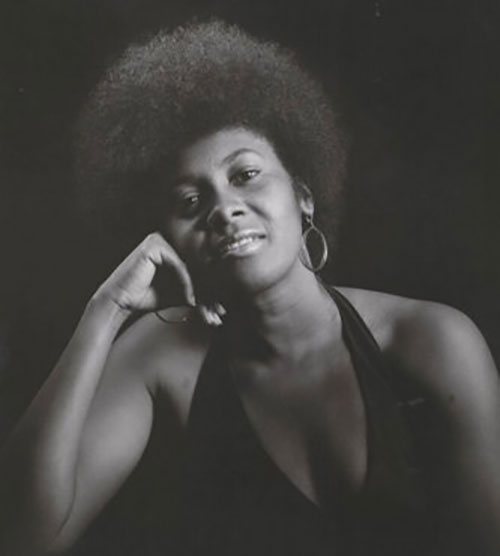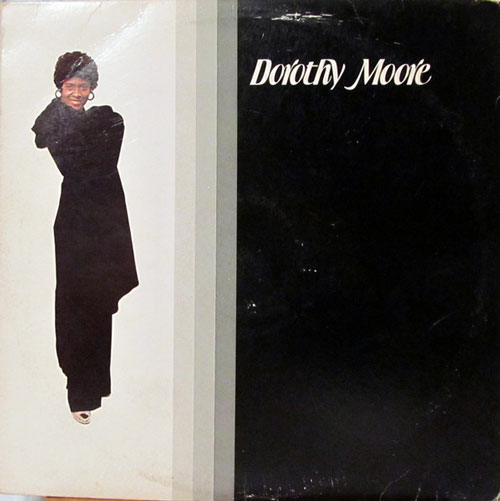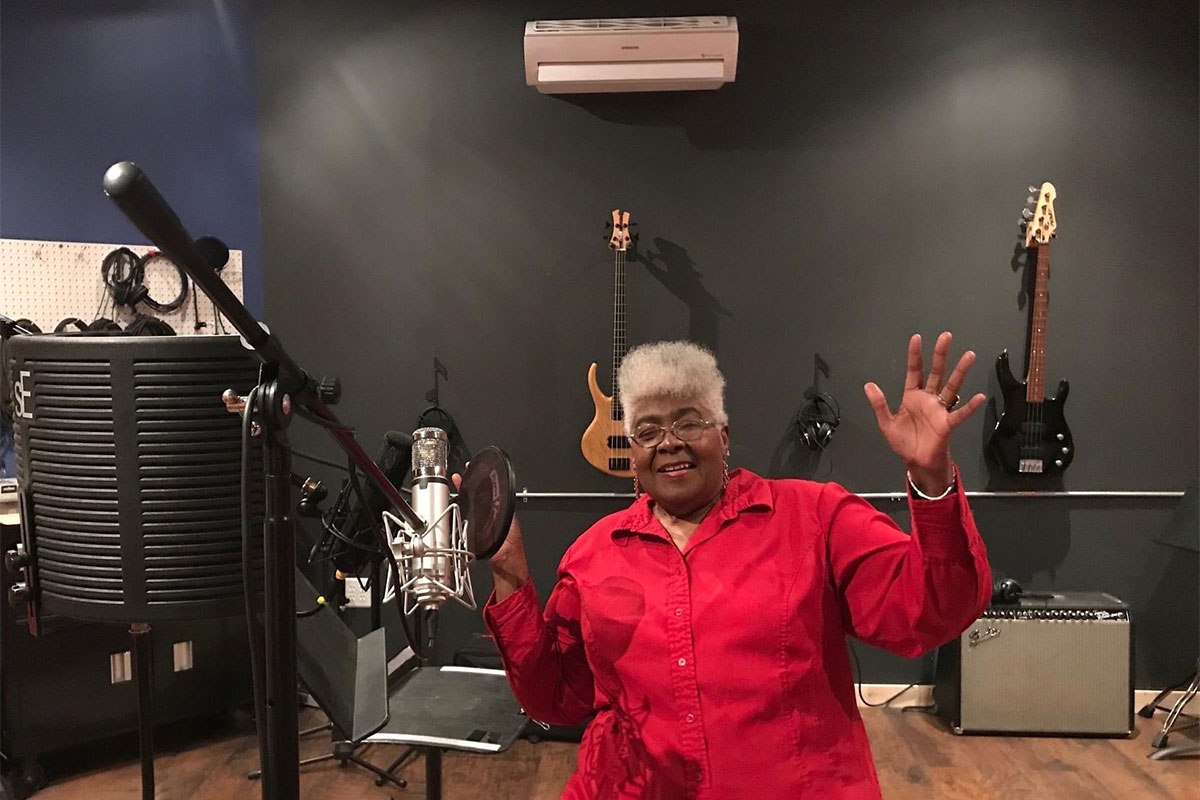By Aliyah Veal
JACKSON, Miss.—“I have a song I want you to listen to,” Tommy Couch Sr. told Dorothy Moore over the phone in 1973.
Putting down the receiver and stepping out of her great-grandmother’s house on Monument Street in Jackson, Moore walked to the nearby Malaco Records. Inside the studio, Couch sat at the soundboard, pressing play and letting music fill the studio with the sounds of “Misty Blue,” a slow, country tune about the struggle to get over a lost lover.
The producer turned toward Moore: “Do you want to record it?” he asked her once the song ended.
“Yes,” she said.
“Do you want to record it now?”
“Yes,” she answered.

Moore entered the studio, studying the music to find the right key. Moments later, she recorded the song in one take, which she does often to conserve her voice.
“I had never lived with that one,” Moore told the Mississippi Free Press.
Typically, Moore likes to listen to a song repeatedly, which she calls “living with a song,” before moving forward with the recording process.
“And when I go into the studio, I know it like the back of my hand,” the singer said. “I mean you can be from any part. It could be in the middle part; it could be three-fourths, one-third. … When I go into the studio, I know it so well that I don’t have to go over it anymore.”
Couch played her rendition of “Misty Blue” after Moore’s session was over, but she was not satisfied because she felt like she could do more, musically. However, her producers thought the song was fine the way it was, convincing her not to go back in and add to it.
But it took time for “Misty Blue” to turn Moore into a major musical star.
‘Dorothy, It’s Playing Again!’
Dorothy Moore recorded two more songs for Couch that day, both of which hit the airwaves before “Misty Blue,” she recalled. In fact, Malaco Records, her label at the time, shelved the song for two years before “Misty Blue” reached the radio in November 1975.
“They didn’t feel that it was a good song to release at the time,” Moore said. “Over two years, (the label) was just sitting around, and I think I heard they were going bankrupt. They didn’t know what to do, and they were broke. They decided to release (the song).”

At the time, Moore worked at School Pictures, which sold class rings and graduation caps and gowns. The radio was playing in the background while they worked, and every time her song would play on the radio, her co-workers did not hesitate to remind her, she remembered.
“Every time ‘Misty Blue’ would come on, somebody would holler across the room, ‘Dorothy, it’s playing again! They playing Misty Blue again!’ And I just smiled,” Moore said.
The song gained much success on the charts, reaching No. 2 on the R&B Singles chart, No. 14 on Adult Contemporary chart, No. 3 on the Billboard Hot 100 chart and top 10 in the U.K., Canada, Australia and New Zealand. The song was also nominated for Best Female R&B Vocal Performance and Best Rhythm & Blues Song at the 19th Annual Grammy Awards.
“‘Misty Blue’ is still keeping the peas on my table,” the singer mused.
‘I Could Sing’
Dorothy Moore was born on Oct. 13, 1946, in her great-grandmother Minnie Mitchell’s house in Jackson, the same family member who primarily raised her. She attended Smith Robertson Elementary School, which is now the Smith Robertson Museum and Cultural Center in downtown Jackson.
Her mother, Mary Moore, was a singer who received a scholarship in voice to attend Jackson State University. Her father, Melvin Henry Sr., was part of the vocal group, The Five Blind Boys of Mississippi.
Her father would visit with Dorothy when she was young, even when she did not know he was her father. There was something special about him, the singer said.

“My great-grandmother would go out the room. I never felt there was danger. It was just a good feeling about him,” Moore recounted. “He would sing to me. He’d sing gospel and blues. I heard him, and I would look at him. I’d read his lips as he sang.”
Moore described her great-grandmother as a strong woman and the woman of the house. She took care of the bills and handled the money between her and her husband, the singer said.
“She could paint her house if she had to. I’d seen her paint some rooms inside the house. I saw her put a tool sack around her waist with nails … and a hammer while her husband went to work,” she described.
When Moore was 3 years old, her mother discovered her vocal ability. By age 5, her grandmother had gotten her a spot in the New Strangers Home Baptist Church choir.
“My great-grandmother made me go to church. We went day and night. I participated frequently in my church,” Moore said. “I would sing in my church’s choir. … I sang solos by myself. I was just like those kids who can play basketball or run track, but I could sing. That’s what I did.”
Moore grew up listening to gospel acts like Shirley Caesar and the Caravans and later began listening to other artists like Aretha Franklin, Gladys Knight and The Supremes. She entered talent competitions at her high school, Lanier High, and performed at venues around Jackson like The Alamo Theatre.

“My great-grandmother was my chaperone … and we would walk to the Alamo on Wednesday nights,” the singer said.
The Alamo held talent shows every Wednesday from 6 p.m. to 8 p.m. The first time she performed at the theater was for a benefit concert for a woman whose house caught fire. Her great-grandmother had signed her up for the concert, she remembered.
Moore credits her Lanier High choral teacher, Naomi Sam, with teaching her everything she needed to know as a singer. By the time Moore began attending Jackson State University, where she majored in voice and minored in piano, she was already prepared.
Harmonizing, how to properly hold a microphone and sing through it, sight singing—she knew how to do it all, and they were easy for her, she said. When she got to Jackson State, she was surprised to find that the choir was teaching things she had already learned in high school, the singer said.
“(Ms. Sam) gave me an assurance that I have; in other words, I’m not afraid to make moves,” Moore said. “I can do things. I can scat. I can sing jazz. … I can do R&B. I can do Blues. I can do Pop. I can do gospel. I can even yodel.”
‘I Think You Have a Hit’
During her senior year in high school, Producer Bob McRee had knocked on Moore’s door with an offer for a recording contract after hearing from locals about her vocal ability. After Moore graduated in 1965, he signed her, with a co-sign from her great-grandmother, and Moore became one-third of the vocal group, The Poppies, alongside Rosemary Taylor and Petsye McCune.
“One of the Poppies went to the same school that I went to, but she was in a higher grade than I was,” Moore said. “The other Poppie was already at Jackson State. When we got together as a group, one was a sophomore and the other was a junior (in college).”
The trio signed to Epic Records, and their single “Lullaby of Love” was a hit for the label. The Poppies stayed together for two years. By the time the group dissolved, Moore was no longer enrolled at Jackson State. She did, however, begin doing background vocals for artists such as King Floyd, Jo Jo Benson and Jean Knight.
In 1975, Moore signed a record contract with Malaco Records as a solo artist and performed background vocals for Johnny Taylor, Bobby “Blue” Bland and others.
“My producer eventually called me and asked me if I wanted to go on the road,” she said. “I didn’t know what he meant by ‘on the road’ because I hadn’t heard that before, (but) he said, ‘I think you have a hit.’”
The singer quit her job at School Pictures and toured across the United States, meeting artists and musicians whom she had idolized growing up. Her debut album, “Misty Blue,” was released March 1, 1976. It reached No.10 on the Billboard R&B Albums chart and No. 29 on the Billboard 200.

Moore would go on to record 11 more albums under three major labels before she started her own record label, Farish Street Records, where she produces her own albums. Moore said she learned the skills necessary by watching and listening to the producers who worked on her albums.
“A producer tells everybody what to do and plans the whole album out,” she explained. “In other words, I select my musicians, where I want to record; I select the songs I like, or somebody might bring it to me by way of the musician.”
Moore said she prefers being an independent artist, but she does acknowledge the benefits that a major label affords such as resourceful connections and the additional money.
Mississippi Blues Trail Marker
The Mississippi Blues Commission created the Mississippi Blues Trail in 2006 to commemorate the history and legacy of blues music in the state. The markers, which are scattered throughout the state, tell stories of bluesmen and women and how the places where they lived and the times in which they existed influenced their music. Markers can be found on city streets, train depots, clubs, churches, cemeteries and other places significant to their respective honorees. l.
Before her marker ceremony, the “Misty Blue” singer had not sung live since the beginning of the pandemic, she said. In fact, she had made the decision to quit music after her last album, “I’m Happy With the One I’ve Got Now,” did not do well commercially.
“One of the reasons (was) because everybody stopped working,” she explained. “The places I knew that I could go to to sell my CDs, they shut their doors, too. Radio stopped working, live DJs stopped working, they closed the door. That hurt as far as me getting my album out there.”
With 56 years in the music industry under her belt, Moore thought it might be time for her to retire, but the audience turnout at her Mississippi Blues Trail marker ceremony and the outpouring of love she received shocked her and changed her mind, she said.
Initially, she was not going to perform at the ceremony, but as the date got closer, she elected to prepare a few songs.

“I said, ‘Well, I’m going to sing three songs,’” Moore said. “I wanted my band to play. When I told my band to rehearse, I gave them an extra song to rehearse just in case the audience wanted me to sing again. And when I walked off that stage, the audience was still applauding, and I decided to use that third song.”
Moore sang her signature country ballad, “Misty Blue,” and a blues song where she also played the harmonica. That performance revitalized her passion and finalized her decision to continue making music.
“When I did that, all of those feelings came back that I love,” Moore said. “I told my agent that I want to do a country album. And what made me come to that decision? Majority of my hits were country before I recorded them,” she said.
‘This Is A Legend’
Peggy Brown was attending the Chicago Blues Festival in 2006 with her friend, Carol, who books and manages music artists. Brown works in the same field, managing singer King Edward Antoine.
Dorothy Moore was performing on the big stage when Brown received backstage access to take some photos of the singer while she performed. Brown knew Moore’s manager, Marcia Weaver, and some of the musicians in her band.
Moore began to perform “Do Ya” from her “Stay Close to Home” album. Brown snapped a photo of Moore from behind as she sang to a large crowd with the Chicago skyline in the background.
“Her voice is awesome as usual, and here I was not just as a spectator—but I felt like I was a part of the entourage and a part of the band,” Brown told the Mississippi Free Press. “I don’t even know how to describe it (besides), ‘Oh my word, this is a legend.’”

Brown went from spectator and fan to Dorothy Moore’s agent after the singer and her previous manager approached Brown about an opportunity to help the singer get booked for more events.
“They were noticing all the places that I was getting King Edward (booked to perform) and all of the things that were happening for him,” she said. “Dorothy approached me one day and said that ‘Marcia (Moore’s former manager) and I have been talking and wanted to know if you would maybe try to help me book some places.’”
Honored, Brown accepted the position. Since then, Brown has put Dorothy Moore’s name in different circles to see what events and opportunities she can book for the Jackson singer.
“She deserves so much. She’s been under the radar for a while, and a lot of folks didn’t even know she was performing still,” the agent said. ”After a while, there were people calling, but at first it was like, ‘What can we get done for her?’”
In 2020, Brown and Moore were having a conversation about markers after a musician at the time, whose name Brown can’t recall, had just received one. Brown told Dorothy that she needed a marker, she remembered.
“I don’t think I’ll ever get my own marker,” Moore told her.
“Well, you deserve your own marker,” Brown countered. “There were people that have gotten markers that haven’t accomplished nearly the things you’ve done or have the career that you’ve had internationally, and not just Mississippi.”

Dorothy Moore had been mentioned on five other markers like the one for the Alamo Theater on the Mississippi Blues Trail, as well as the Marty Gamblin marker on the Mississippi Country Music Trail. So, Moore was well overdue for her own, Brown decided.
Brown saw Visit Mississippi Bureau Manager of Tourist Development Kamel King, who oversees the blues markers for the state, at Mississippi Public Broadcasting while he was doing a radio show. She asked him if he thought Moore’s career would merit a marker on the blues trail.
“He calls her ‘Queen Moore,’ and he said, ‘Queen Moore needs her own marker,’” Brown recalled. “I said, ‘Well, what do I do?”
‘Worldwide Appeal’
In 2020, Brown filled out an application with the appropriate documents to Visit Mississippi, but she did not hear back immediately due to the pandemic. She got in contact with King in 2021, and he asked her to reapply. This time, she received a response, Brown said.
“(King) said that it was being presented at the next blues commission meeting, and … he would let me know what they thought,” she recalled. “Well, hands down it was like, ‘Yeah, she needs her own marker.’”
The historian committee gave the final seal of approval for Dorothy Moore to receive her marker. The next step was ironing out the costs of the marker, which can be pretty expensive.
“It’s almost $9,500,” Brown said.
When the Mississippi Blues Trail first started, grants from The National Endowment for the Arts paid for the markers. But once the grant money stopped coming, the person or entity representing the person had to come up with the money to pay for the marker, Brown explained.

Visit Jackson volunteered to pay for half the marker, leaving $4,200 that Brown had to come up with, which she said was not a problem in Moore’s case. She set up a Facebook fundraiser and received donations from the Mississippi Delta Blues Society of Indianola, the Central Mississippi Blues Society and other entities.
In three months, she had raised the required funds. The next step was picking a location for the marker.
“She decided rather quickly that she did not want the marker to be down the street she grew up in because she didn’t think tourists would want to go down Monument Street,” Brown said of Moore.
“I said, ‘I totally understand what you’re saying, Dorothy. Where is some other place that you would like to place that sort of represents you?’” Brown remembered. “She said, ‘Jackson State because I was a student there when I became a Poppie.’”
Brown reached out to Dr. Robert Luckett with the Margaret Walker Center on the university’s campus and informed him that Dorothy wanted a marker in front of the FD Hall Music Center, if they could get permission. Brown playfully dubbed Luckett (a Mississippi Free Press advisory board member) as her “partner in crime” through the entire process, from the marker ceremony to the reception. She said she did not know how much work was involved in planning a marker ceremony, so she greatly valued his help in helping the event run smoothly, Brown said.

“It turned out to be a delightful experience for me,” the agent said. “I will never have another experience like this where I was involved in all aspects of it. It was such a wonderful, fulfilling project, and (Moore) is just beside herself about her marker.”
Brown said she got in touch with the historian who wrote Dorothy Moore’s marker because they wanted it to reflect not only Dorothy’s accolades in the United States, but her international accolades as well—the full scope of her legacy.
“I think the marker in that respect speaks to her legacy as bigger than Mississippi, truly being worldwide,” Brown said. “And to this day, on iTunes blues charts, “Misty Blue” usually stays in the top 10 in the U.K. In the states, it’s maybe 15 or something close. That, to me, speaks of her worldwide appeal.”
This article was first published by Mississippi Free Press



